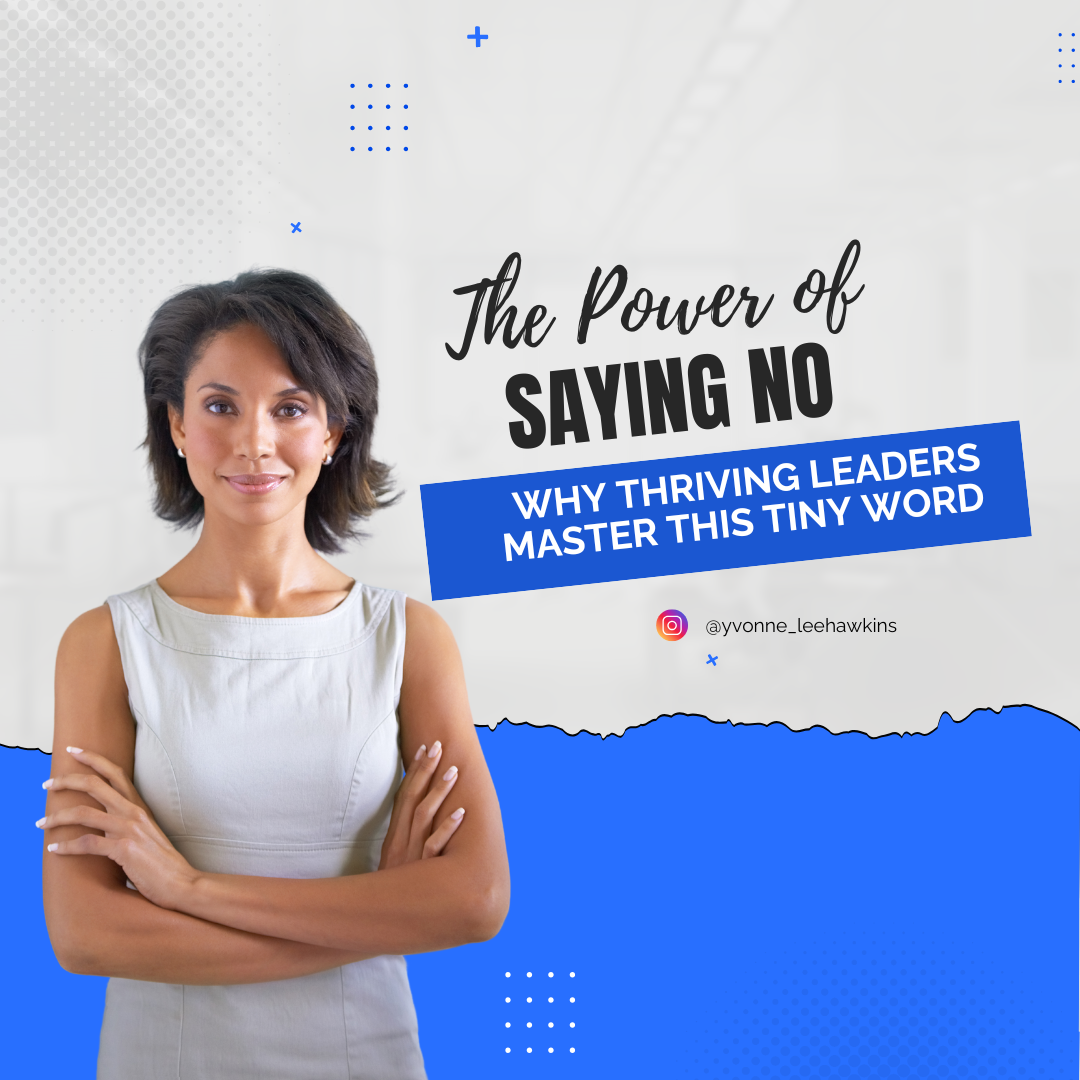Leadership isn’t just about vision, action, or influence, it’s about judgment. And one of the most underrated tools in any leader’s toolkit is a simple, two-letter word: No.
In our current hustle-harder culture, we glorify saying yes—to new projects, late-night emails, and “just one more thing.” We reward availability over boundaries. But real leadership isn’t about doing more. It’s about protecting what matters most.
Saying no isn’t selfish, it’s strategic. It’s not a rejection of others; it’s a commitment to your priorities, your people, and your purpose.
Whether you’re leading a business, a team, a family, or your ability to say no shapes the culture around you and the outcomes ahead of you.
Let’s explore why saying no is a leadership superpower—and how it can protect your energy, sharpen your impact, and change everything.
Why “No” Is a Leadership Superpower
- It Prevents Burnout
Overcommitting is one of the fastest roads to exhaustion. When you say yes to everything, you leak energy everywhere.
Last year, Business Insider featured my story: I was leading 21 direct reports across 8 countries and 16 time zones. On paper, I was succeeding. Behind the scenes, I was unraveling. I said yes to another team when I should’ve paused to restructure the org. I cared deeply about the people—but my bandwidth was shot. Ironically, my desire to serve was the very thing that led me to crash.
Lesson learned: What serves others doesn’t always serve you—and that matters.
- It Models Healthy Boundaries
People don’t learn from what you say. They learn from what you tolerate.
I once worked with a senior leader who emailed the team at 3 a.m. Justifying it with, “I’m already awake with the baby,” he didn’t realize he was setting off a quiet culture of anxiety. Team members were already logging in at 6 a.m., terrified of missing something. One of the managers under him insisted that a team member be available for an evening call on her wedding anniversary. It wasn’t an emergency, or even anything critical, just the beginnings of a toxic culture. I gently nudged him to use “delay send.” Sometimes modeling balance starts with a setting in Outlook—and a mindset shift.
Saying no to over-availability teaches your team it’s okay to protect their own peace.
- It Sharpens Strategic Focus
Every yes has a hidden cost.
When Jeff Bezos founded Amazon, his goal was to become “the everything store.” But he didn’t start there. He said no to everything—except books. Why books?
- Huge variety (more than any store could stock)
- Low cost and easy to ship
- Standardized (no need to try before buying)
- Easy to categorize and search (thanks, ISBNs)
By starting narrow, Amazon built scalable systems, earned customer trust, and created a launchpad for massive growth. Had Bezos said yes to selling everything, the business might have imploded. His disciplined no laid the groundwork for an iconic yes.
- It Builds Respect
Here’s a truth bomb: People don’t respect leaders who say yes to everything. They respect leaders who stand for something.
Look at In-N-Out Burger. While competitors roll out new menu items every quarter, In-N-Out keeps it ridiculously simple: burgers, fries, shakes. That’s it. No gimmicks. No distractions. And guess what? That simplicity creates fanatical loyalty.
By saying no to expansion and trend-chasing, they say yes to quality, speed, and brand integrity—and their customers love them for it.
- It Empowers Others
Sometimes your no is the space someone else needs to rise.
When Will Smith was offered the role of Neo in The Matrix, he turned it down. The script confused him, so he passed. That no cleared the way for Keanu Reeves—who not only embodied Neo, but helped make the film a cultural phenomenon. Can you even imagine Will Smith playing Neo?! I can’t.
A graceful no doesn’t close a door—it opens the right one, for the right person.
5 Real-World Scenarios Where No = Leadership
- “Can You Just…” Tasks That Aren’t Yours
You’re constantly asked to take on extra admin. “Can you throw together the deck?” “Can you follow up with the vendor?”
The empowered no:
“I want to support the project’s success, but creating decks falls outside my scope. Who on the team owns that?”
- After-Hours Messaging
Your team starts texting at 10 p.m. You’re tempted to reply.
The empowered no:
“I unplug after 7 p.m. so I can recharge fully. Let’s sync in the morning.”
When leaders unplug, teams learn they’re allowed to, too.
- Hosting a Holiday Dinner (When You’re Exhausted)
Your family assumes you’ll host again—even though you’re burned out.
The empowered no:
“I love our time together, but I won’t be hosting this year. I’d be happy to bring a dish or help another way.”
This sets a new precedent: Your energy matters at home too.
- Back-to-Back Meetings
Your calendar is a wall of Zoom boxes with no time to think.
The empowered no:
“I’ve blocked no-meeting windows twice a week for strategic work. Let’s find another time.”
Boundaries protect brilliance.
- Toxic Clients (Even If They Pay Well)
A high-paying client constantly misses deadlines and disrespects your team.
The empowered no:
“After evaluating our priorities, we’ve decided not to move forward with this engagement.”
Early in my business, I had to fire clients who wanted coaching—but never did the work. I realized no amount of sessions could move someone unwilling to grow. Now, I screen for fit. If they’re not ready, I say no gracefully—because my integrity, energy, and outcomes depend on it.
How to Practice the Art of a Graceful No
A powerful no doesn’t require harshness. It just requires clarity. Try one of these:
- “I’m at capacity right now.”
- “That’s not something I can take on, but here’s what I can offer…”
- “That doesn’t align with our current goals.”
- “Thanks for thinking of me, but I’ll have to pass this time.”
And if guilt creeps in? Remember:
Every time you say yes to something that drains you, you say no to something that fuels you.
The Bottom Line: Say No to Protect the Yeses That Matter
Your energy isn’t infinite. Your time isn’t elastic. And your legacy isn’t built on saying yes to everyone.
Saying no is how leaders protect their vision, model sustainability, and stay aligned with what truly matters.
So, the next time someone asks, “Can you just…,” ask yourself:
“Does this serve my purpose, or steal from it?”
Because when you say no with courage, you say yes to your peace, your power, and your potential.
***
Did this topic add value to you? Please like and subscribe if you want more topics like this, or DM me. I always love suggestions and feedback!
And if you are too burned out and overwhelmed to even begin to use any of these strategies it might be time to get help. Find a coach, therapist, or doctor who can help you reverse out of the physical, mental, and emotional symptoms of burnout so you can get back to living in life you love.
Remember, Self-care isn’t selfish…it’s required!
Yvonne Lee-Hawkins, IPHM, is a holistic Leadership and Wellness coach, stress strategist, and writer, who spent 20 years in corporate and leadership functions while also being a wife and mom of three amazing kids. You can find out more on her website, or follow her on Instagram, LinkedIn, or Medium. If you want some help beating burnout and all that comes with it, schedule a call here.

